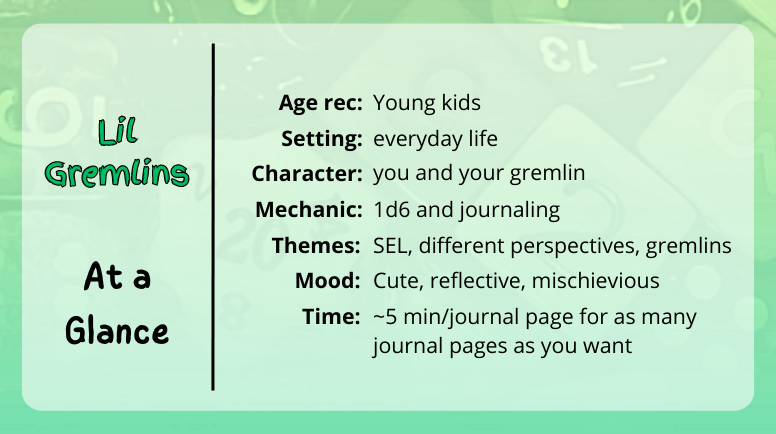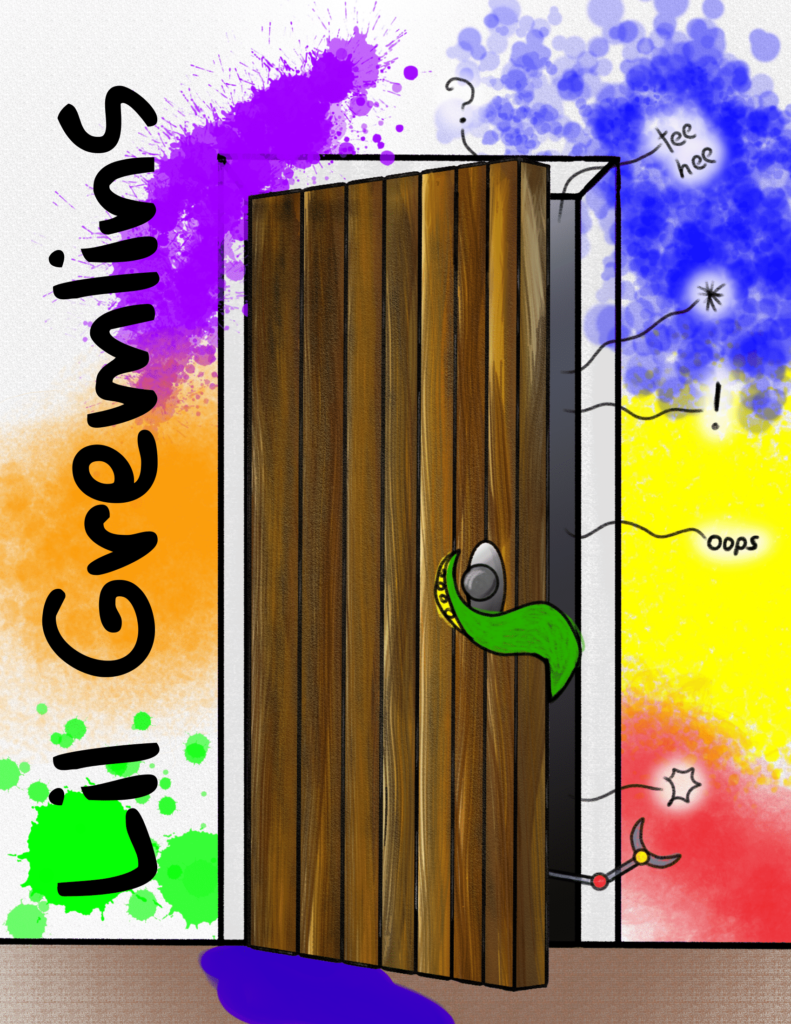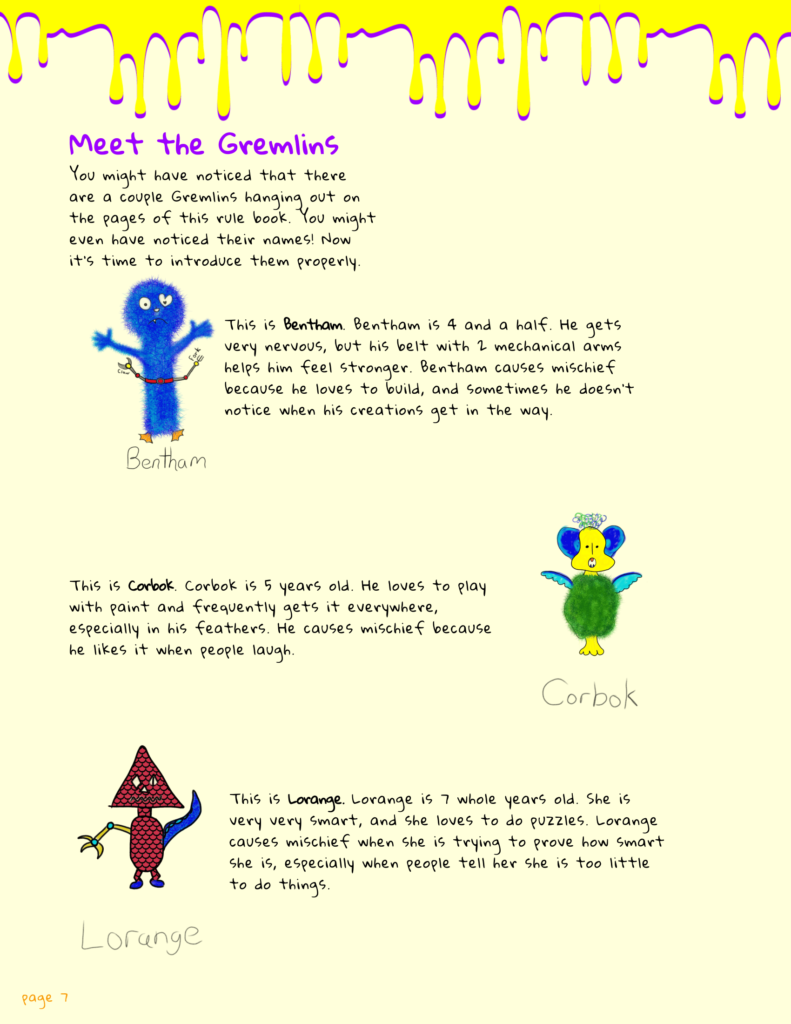Review of Lil Gremlins, an SEL journaling game for kids and their grownups
*note that this review was done based on a playtest copy, so exact rules, journal entry pages, etc may differ from the final game

Jump to:
Lil Gremlins is great for little kids (some help with writing needed) AND their grown ups

Lil Gremlins is perfect for young kids who can understand simple prompts and who are working on understanding cause and effect. They don’t need to read since their grownups can help them with the reading and journaling bits, and kids can still participate in the journal via boxes for drawing, doodling, and coloring alongside with the writing.
The focus for this game is on practicing social emotional learning skills and understanding how mischief caused by our gremlin can sometimes cause other problems… and then figuring out what to do about them. If your kid is still working on these concepts and trying to understand them, this game is perfect. It’s intended to practice and strengthen those reasoning skills and look at that mischief from a different perspective.
It is also great for grownups because, through responses from kids, we can see how they perceive us handling their mischief. This game is a good way to hold up a mirror to our own behavior and see how our kid is reflecting that in their answers to the journaling prompts.
Lil Gremlins is set in everyday life
Lil Gremlins is set up to be run in your home or classroom (or wherever else you may be playing this game) with your imaginary gremlin carrying out their shenanigans in that space. This is really good for getting you and your kid to think about how our own shenanigans fill that space too.
If you roll up that the gremlin was climbing on a chair and it fell over, it’s sometimes easier to reflect on that behavior when you can walk over and ask if that was the chair they used. Or, if they drew on a doll’s face, maybe we find a doll (that kiddo approves of) and pretend that was the doll the gremlin used. It’s a little closer to home for some of the prompts, and it was easy to help explain to kiddo, and I think help him visualize, how both our gremlin’s action impacted the space in the game… and compare it to how my kid’s actions impact the same space outside the game.
Your character in Lil Gremlins

Lil Gremlins kind of has two characters that you’re working on at the same time. The first is you, as yourself, reacting to the gremlin. The second is the gremlin. You roll for how they act and they’re framed as an NPC that you respond to, however, they are also just as much your character in the game as you are.
You talk about how both you and the gremlin feel, what you and the gremlin do, and how you and your gremlin can help the situation. While it may seem, on the surface, that your character is yourself, you do frequently flip perspective between yourself and the gremlin, which is an awesome tool for helping kids learn to see both sides of a situation or discussion.
Mechanics and SEL in Lil Gremlins
Lil Gremlins focuses on using 1d6 to create situations from roll tables that tell you what your gremlin is doing each day. Then, you role-play what the gremlin does, how it ends up causing trouble, how everyone feels about that, and what you all do as a result. This is all recorded in a journal that showcases your story with your gremlin until they finally graduate and go off into the world on their own.
This mechanics set is easy for kids to pick up since the math is reading and recognizing numbers without needing to worry about adding modifiers, and the main focus, then, falls onto the RP and journaling elements.
One key example from the game we played was that we rolled that the gremlin climbed up onto the top of a chair. This is something that my kid does ALL the time while pretending to be Spiderman, and we constantly are asking him to get down so he doesn’t fall and get hurt.

When we rolled up the scenario, we asked what happens next, and my kid said that the gremlin fell and got hurt, and then proceeded to walk through taking care of his gremlin’s boo-boo, explaining why we don’t climb on chairs, and hugging him and reading a book.
First… It was adorable.
Second, it was a massive win for my kid recognizing that there can be a consequence and being able to explain, outside of himself, that cause and effect.
Third, his first reaction wasn’t to yell at the gremlin or punish him, it was to take care of him, which was a major proud parent moment AND showed me that he could understand that compassion.
Bonus mechanics: MEGA MISCHIEF and FRIENDLY FUN
There’s a bonus mechanic in Lil Gremlins where you can roll 1d6 to see if your gremlin goes along with your plan, reframe, or request to stop their mischief each day. You see if that day is a grumpy day (for not going along) or a happy day (for being OK with it). If you get three in a row of one or the other, a special event happens!

For Friendly Fun days, your gremlin does something super nice, like making an art project. We happened to get one of these days in our game: he made a spaceship craft, and we were able to contain some of the arts and crafts mess before it got everywhere too!
For Mega Mischief days… three grumpy days in a row means your gremlin gets fed up with being told no and goes a little wild. They intentionally try to cause trouble and do something big like yelling super loud until a window breaks or using magic to cause a big storm! On those days, you talk about what happened, what led to it, and how you (as yourself) feel about it too.
It’s a good way to see how that cause and effect has an impact over time, and not just from day to day. There’s definitely been times where rough days build on each other, and this can be a really good opportunity to talk about that and then compare back to when we see it happening in real life.
What did my kid think about Lil Gremlins?
My kid thought this game was kind of funny. While it did focus a lot on SEL skills and reflection, he thought the gremlin was silly and got very attached to them, even though they were causing trouble. He even once said while we were playing that the gremlin was the baby and he was the daddy and got really into the idea of playing parent to his wonderfully odd and wild triangle headed gremlin child.
Some moments were definitely a little tough, not because of the game or anything, but because we were working through some tough discussions about how we felt about certain things like… what if the gremlin scribbled on our favorite toy or smashed a plate. Even those discussions, he was actively engaged and I think enjoyed it at the end, especially with how connected he seemed with his gremlin baby.

Overall thoughts on Lil Gremlins
This game is great for both kids and grown ups to play together and be able to see from each others perspectives within the frame of the game and while talking about the imaginary gremlin in a semi-removed manner. It was lighthearted enough to still be fun and engaging while also touching on poignant enough topics and questions to give an impactful learning experience. It has a wonderful frame to work within while also giving wide room for creativity and discussion. We had a great time trying this game out, and I hope you do too!
Find a copy of Lil Gremlins
You can find a copy of Lil Gremlins here on the Open Story Games itch.io page!
If you liked this post, make sure to subscribe to the TTRPGkids monthly newsletter to stay up to date on the latest reviews, tips and tricks, game and podcast list updates, and more! Thank you for playing tabletop RPGs with your kids and sharing this awesome hobby with the next generation!


